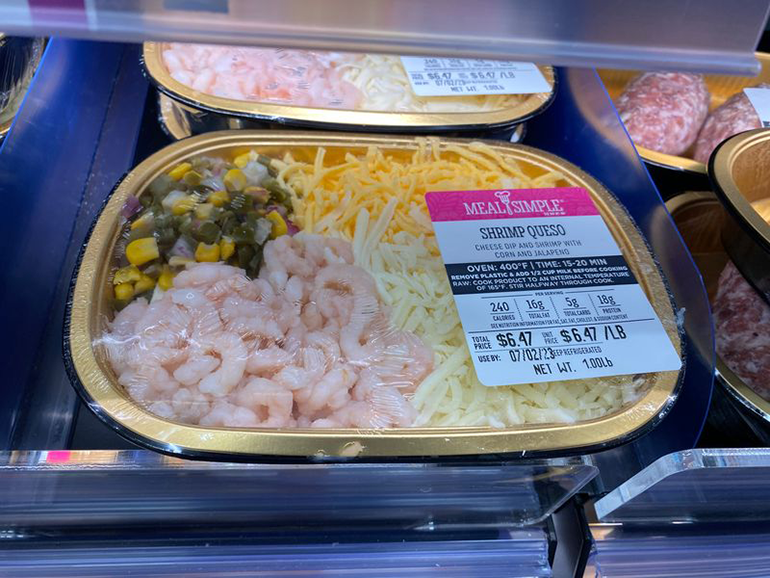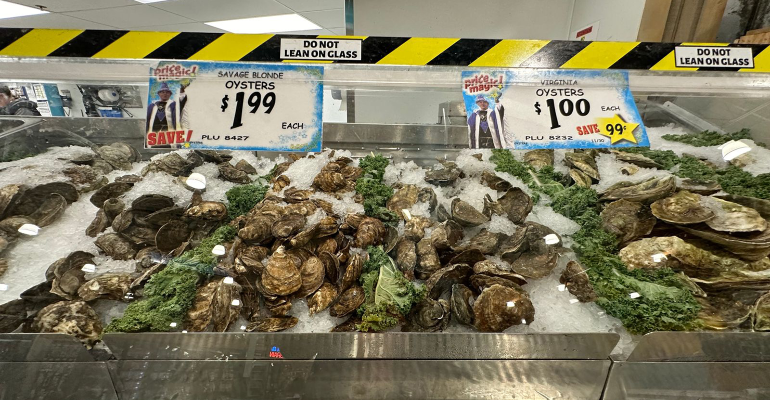The shellfish sector is reaping the benefits of declining seafood prices.
Triggered in part by a stronger supply chain, fresh shellfish had an average per pound price of $8.04 for the 52 weeks ending Jan. 28, down 6.8% from the year-earlier period, reports Circana, a Chicago-based market research firm. Volume sales were up 1.3%.
Fresh crab, the most popular fresh shellfish item, had the biggest price decline — 17.2%, which led to a 24% increase in volume sales.
In contrast, fresh finfish had an average per pound price of $10.37, up 1.4%, with a volume sales decrease of 3.8%.
Retailers were merchandising a weekly average of 17.5 refrigerated shellfish items in the store in 2023, along with an average of 31.6 frozen shellfish selections, Circana states.
“Having strong categories like crab drives traffic and sales to the seafood case,” said Chris DuBois, Circana executive vice president of the protein practice. “You won’t have a successful case without a great supply of crab as it also attracts the people who will buy other species as well.”

Some retailers are including shrimp, the most popular seafood item, in ready-to-cook meal solutions.
That is important as the amounts of shoppers purchasing seafood is declining, he said. “There is a very strong set of heavy and medium seafood buyers in the category, so the big challenge for retailers is igniting the people who are buying less.”
Just 10% of seafood buyers, for instance, are purchasing 45% of all seafood, DuBois said, with the frequent purchasers tending to be older with higher incomes. Because of steep prices, many potential buyers are eschewing seafood, even when it is on promotion, he said. “Higher prices throughout the economy are dampening demand, and that is occurring in almost every food category.”
It is making it difficult for retailers to expand fresh shellfish sales, particularly as many younger consumers are focusing on sushi and other items that are easy to prepare, DuBois said, adding that value-added selections are generating about 30% of overall seafood activity.
Retailers should create a perception of convenience to help increase fresh shellfish revenues, he said, noting that merchandisers can make it easier for shoppers to sort through the myriad crab and shrimp selections and offer sizes that are simpler to cook.
“The more technical you make the seafood case, the more intimidating it is for consumers,” DuBois said. “The more attractive that retailers can make it, the better.”
In addition to spotlighting the most popular shellfish, including shrimp, crab, and lobster, providing more product information, such as geographic origin and recipes, will generate more interest in the category as well, he said. Retailers also can use loyalty card data to identify the individuals who are most likely to purchase shellfish and market to them online, DuBois said.
“It is more about actively communicating product details and less about just hoping that shoppers will see what is in the case as they walk by,” he said. “Making them feel important to the seafood department is a very straightforward marketing exercise.”
It is perhaps most essential, however, that operators aggressively support seafood merchandising.
“Retailers must decide if they are going to be all-in for the seafood department and category or not,” DuBois said, noting that a lackadaisical approach will waste the use of employees who might be more effective in other parts of a store and lower the ability to attract more customers to seafood.
The ultimate result will be losing the current seafood shoppers, who typically have a much higher overall basket ring, as “they are likely to walk at some point,” he said. “Retailers must balance the operational side with the need to drive sales.”
While merchandising shellfish in the frozen case often provides retailers with the space to offer additional varieties that have a longer shelf life, DuBois said it still is essential for seafood departments to have vibrant full-service counters.
“The fresh cases create theater and excitement for the store,” he said. “Frequent category shoppers like it.”
Regardless of whether the shellfish is fresh or frozen, a key retailer focus should be on making shopping and food preparation simpler, DuBois said, which can include providing recipes for specific selections and cross merchandising the shellfish with relevant ingredients from other store departments, such as marinades.
“Most consumers are not going spend a lot of time trying to pick out the appropriate items for a seafood meal,” he said. “The easier retailers can make it for them to follow the recipes and cook the seafood without having to seek assistance from the employees at the seafood counter, the better.”





